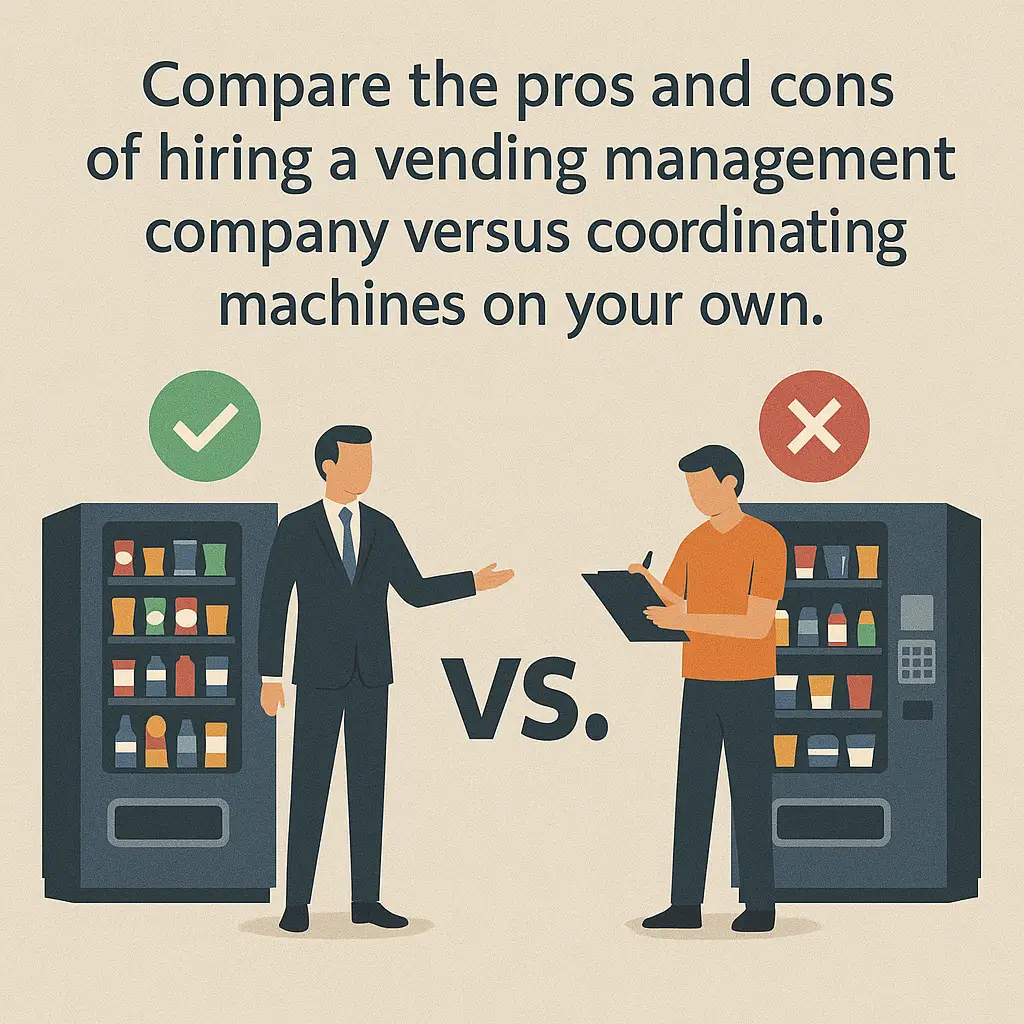Vending Management vs Self-Managed Service
Compare the pros and cons of hiring a vending management company versus coordinating machines on your own.
Back to Vending Management Companies ResourcesCompare the pros and cons of hiring a vending management company versus coordinating machines on your own.
Back to Vending Management Companies ResourcesVending management services offload the coordination, servicing, and stocking burden from your staff. While self-managed setups offer more control, they demand significant time to oversee vendors, monitor stock, and handle machine issues directly.
![]() Management companies handle all restocking and equipment issues
Management companies handle all restocking and equipment issues
![]() Self-managed service may lack vendor accountability
Self-managed service may lack vendor accountability
![]() Professional services often include contactless payment tech
Professional services often include contactless payment tech

When setting up vending machines for your business or property, choosing between a managed vending service and a self-managed model can significantly impact convenience and performance. A managed vending service connects you with a reliable vendor who restocks products, maintains machines, and ensures equipment is functioning properly—often all at no cost to you.
In contrast, self-managed service means your organization either owns the machines or directly liaises with one or more local vendors on your own. While this approach may offer more control over product pricing or revenue sharing, it also requires more time and oversight. This includes coordinating installations, handling service calls, managing inventory, and resolving vendor issues.
Managed vending services offer several advantages: fast installation, accountability, and streamlined communication. They also tend to provide modern equipment featuring cashless payment options and energy-efficient designs. These machines are typically monitored remotely, allowing quick resolution of errors or out-of-stock items.
With self-managed vending setups, cost-effectiveness may seem like a plus in the early stages but often leads to inconsistent service or specialized labor demands. If a machine breaks down, your team must follow up with technicians or suppliers, adding time and frustration. Plus, you may not have access to premium machines like micro markets or smart coolers capable of contactless payment and remote tracking.
Additionally, managed services usually bring in partners who understand specific location needs. For instance, schools may benefit from vending machine types that focus on healthy and compliant options for students. A management partner ensures those unique requirements are met consistently.
Ultimately, deciding between managed and self-managed vending depends on your resources, expectations, and risk tolerance. If you value vendor accountability, smart technology, and hands-off operations, vending management is a strong choice.
If you're exploring vending options for your business, Vending Exchange can help simplify the process. Delivery, Installation and Equipment is provided at no cost to you - vendors provide the machines, keep them stocked, and handle all servicing. Whether you need a provider or full-service management, just fill out the form on this page to get started.
Managed vending involves a company handling machines, stocking, repairs, and service. Self-managed means you handle vendor relations and equipment directly.
No—the service itself is typically free to qualified locations. You only pay for the products consumed.
In a managed system, the vendor handles repairs. In self-managed setups, you coordinate with technicians or service providers.
It can be time-intensive, involving sourcing vendors, coordinating restocks, tracking issues, and managing contracts.
Yes—without professional oversight, machines may be left unstocked, outdated, or fall into disrepair.
Yes. Managed vending providers typically offer the latest tech with mobile and contactless payment options.
Yes, you often can request specific products and healthy options based on your location’s needs.
Yes, most are installed within 7 days, including delivery, equipment, and stocking.
Managed services monitor inventory remotely. In self-managed setups, someone from your team must track and reorder stock.
With managed services, you'd be assigned a new vendor quickly. In self-managed systems, you must find a replacement on your own.